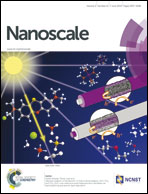Selective isolation of the electron or hole in photocatalysis: ZnO–TiO2 and TiO2–ZnO core–shell structured heterojunction nanofibers via electrospinning and atomic layer deposition†
Abstract
Heterojunctions are a well-studied material combination in photocatalysis studies, the majority of which aim to improve the efficacy of the catalysts. Developing novel catalysts begs the question of which photo-generated charge carrier is more efficient in the process of catalysis and the associated mechanism. To address this issue we have fabricated core–shell heterojunction (CSHJ) nanofibers from ZnO and TiO2 in two combinations where only the ‘shell’ part of the heterojunction is exposed to the environment to participate in the photocatalysis. Core and shell structures were fabricated via electrospinning and atomic layer deposition, respectively which were then subjected to calcination. These CSHJs were characterized and studied for photocatalytic activity (PCA). These two combinations expose electrons or holes selectively to the environment. Under suitable illumination of the ZnO–TiO2 CSHJ, e/h pairs are created mainly in TiO2 and the electrons take part in catalysis (i.e. reduce the organic dye) at the conduction band or oxygen vacancy sites of the ‘shell’, while holes migrate to the core of the structure. Conversely, holes take part in catalysis and electrons diffuse to the core in the case of a TiO2–ZnO CSHJ. The results further revealed that the TiO2–ZnO CSHJ shows ∼1.6 times faster PCA when compared to the ZnO–TiO2 CSHJ because of efficient hole capture by oxygen vacancies, and the lower mobility of holes.


 Please wait while we load your content...
Please wait while we load your content...